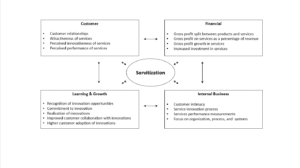The quest for improvement and innovation to build productivity, drive greater value, and seek opportunities in new markets is perpetual for every successful business. As a result, executives and organizational leaders alike continuously evaluate their business models, offerings, and operational processes to gain any advantage they can find, especially when their products become increasingly commoditized.
Based on current research, servitization appears to be an effective antidote against the ease of product switching. McKinsey & Company reports that while margins on new product sales are typically 10%, aftermarket service margins average 25%.
What Is Servitization?
Servitization is a strategy that product-oriented companies use to enhance and differentiate their competitiveness by integrating services into their overall business model. This shift can be seen on a continuum in which producing and selling products is coupled with a focus on adding services to the offering and ultimately integrating them. Very quickly, customer value moves from owning and using the product to capturing value with the product while services are perceived as a cost factor.
While this concept is not new, widespread adoption of intelligent technology – such as the Internet of Things (IoT), machine learning, and predictive analytics – is fueling this approach to break into new markets and fulfill underserved customer needs. More recent product-service servitization models may include bundled support services, consumption or pay-for-use, and outcome-based services.
An earlier form of servitization emerged in 1962 when Rolls-Royce pioneered its famous “Power by the Hour” engine maintenance service concept. This model allowed airlines to pay for the time spent maintaining and replacing their aircraft engine. As technology advanced, sensors were incorporated for engine-condition monitoring and predictive maintenance services.
A few decades later, tire manufacturer Michelin redefined the service-oriented model to help trucking companies reduce fuel consumption. Payment for the service is based on achieving predefined fuel consumption targets, tracked through telematics and IoT, and assessed in real time with data analytics.
Many more companies have followed Rolls-Royce’s and Michelin’s example, including Kaeser Kompressoren, Grundfos, and Tetra Pak. It is noted that in all cases, IT – specifically IoT and Industry 4.0 – plays a significant role in enabling product-service servitization.
Over time, this approach has become a critical component of manufacturers’ growth strategies. In fact, a survey of 60 European industrial manufacturing firms reported that servitization increases average growth margin from services delivered ranging between 15% and 35%. Another survey found that the 10% total returns to shareholders (TRS) achieved by servitization champions significantly exceeded the -1% median TRS of their peers. And in the spirit of these findings, Professor Klaus Schwab, founder and executive chairman of the World Economic Forum, identified servitization as one of the megatrends that will shape the future of business and society.
How to Turn Servitization Into a Revenue Generator
Regardless of the advantages servitization offers, many businesses still question how to best recognize and adopt appropriate service options that deliver the best value to the customer. Some of the challenges encountered include culture change, competency adoption, process, system creation, and commercialization.
In many ways, a transformation journey toward servitization includes four fundamental maturity stages:
- Splintered: The organization struggles under a myriad of silos that lead to disjointed, manual processes. Legacy, fragmented enterprise resource planning (ERP) environments provide little or no visibility on operational performance. The business model is on pure product, with challenges to profitability.
- Side car: The organization has standardized the two chunks of the value chain – back and front desk – but keeps them separated. Since efficiency is critical at this stage, few add-on services are delivered, field services are based on basic mobile capabilities, and IoT stacks are only proofs of concept.
- Joined up: Front- and back-office flows are integrated bidirectionally and leverage advanced technologies, such as IoT, to feed core systems with real-time data. In some cases, edge capabilities bring coordinated autonomy to local sites, a suite of digital services are made fully available, and business model enhancements including pay-as-you-use and outcome-based contracts are actively explored.
- Borderless: Processes start and end outside the organization and operations, while technology enables different elements of the value chain to connect. Co-creation, data-sharing, and collaboration with customers, suppliers, partners from other sectors, and even competitors are part of the business model.
After demonstrating the importance of servitization during existing economic conditions and business performance, appropriate servitization concepts steadily replace the status quo, closing the gap between strategic intent and realized goals.
A critical part of progressing servitization maturity is transforming the business culture to encourage leaders and employees to shift their perception of services from add-ons or giveaways to a valued part of the business model.
According to Guido Schlief, senior vice president and head of Services in Middle and Eastern Europe at SAP, “Our observation is that customers increasingly expect business outcomes from their suppliers – outcome-based services are a clear industry trend.”
Successfully embracing this shift can have a significant effect on the profitability of a servitized business. Deep insights into customer needs are required to design value-added services that are valuable from the market perspective, not from the supplier side. For example, although monitoring of equipment condition has limited value to the customer, equipment availability directly impacts the customer experience.
Product companies must also consider a servitization model that shifts upfront transactional sales and payments to long-term contracts with perpetual payments, enabling customer-centric relationship building. Successful delivery of this approach demands an effective services organization, resembling a professional services firm containing the right processes, tools, and personnel who possess specialized skills. Although service personnel typically cost more than manufacturing personnel, the investment can help overcome critical hurdles, such as lack of knowledge in systematic transformation and the ability to make required changes, in gaining the full benefit of servitization.

Over time, the transformation into a servitization model can be assessed to help ensure it satisfies the core needs of the business: financial, internal, customers, innovation, and learning. For example, pure financial measures – such as service revenue growth or services market share – can be evaluated alongside a proposed a balanced scorecard to provide a comprehensive view on servitization performance (See Figure 1).
Get Ready: Servitization Is Here to Stay
As customers gain less interest in the shiny new functionalities of new products and pay more attention to the outcomes they achieve, all signs point to the growing importance of services as a competitive differentiator.
But remember, servitization is more than a pure vertical integration of the business model and goes far beyond add-on or giveaway services. In essence, it is a strategic transformation that spans across most business silos, requiring alignment between the business and IT and between the front and back office of the supplier.
And if approached appropriately, the new business model can open new sources of revenue and bring a fundamental shift from a reactive break-fix mentality to proactive outcome-based services.
Frits Verhoef is head of Business Transformation Services CXO Advisory, Middle and Eastern Europe, at SAP.



